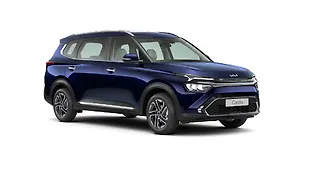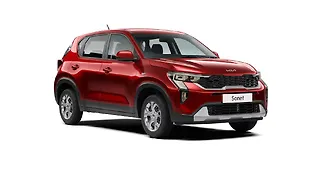What is it?

The Kia Carnival is the Korean carmaker’s second and the flagship offering in India after the well-received Seltos. It is an MPV with a premium touch and is aimed to create a segment of its own while taking a few sales away from full-size seven-seater SUVs like the Ford Endeavour and the Toyota Fortuner. When it will be launched in the country at the upcoming 2020 Auto Expo, the Carnival will be sold in three trim levels – Premium, Prestige and Limousine – across five variants with a single choice of BS6 compliant diesel powertrain.

Measuring more than 5.1m in length, the Carnival stands tall and wide and has an imposing stance. Even the wheelbase is more than three metres. Dominating the upright fascia is the large tiger-nose grille with square-gated design. It is flanked by sleek yet large wraparound headlamps which remind us of the Innova Crysta to some extent. These headlamps get LED projector units while the fog lamps have ice-cube DRLs, as is the trend these days, along with black surround and chrome garnish.

In profile, the humongous proportions of the Carnival become apparent. And similar to the Mercedes-Benz V-Class, the Carnival has those unconventional sliding passenger doors. But even with its boxy silhouette, the Carnival appears to be well-proportioned thanks to the floating roof design and the kink past the C-pillar. It rides on 18-inch wheels and there are two alloy wheel designs to choose from. What you see in the pictures is the ‘Sputtering Finish’ one which looks nice but has too much bling. At the rear, the squared-off tailgate is simple and lacks drama. Even the taillamp design is simple with LED lighting signature and there are faux skid plates on the bumper to add to the rugged appeal. Currently, there are only three colour options to choose from – black, white and silver.

Overall, the Kia Carnival is a handsome and brawny looking people mover. It is large, has an imposing street presence, it demands attention, but is easy on the eye despite the humongous proportions.
How is it on the inside?

The grandeur of the Carnival’s exterior continues on the inside as well. The cabin of the top-spec Limousine trim we are driving here is swathed in Napa leather upholstery, soft-touch materials on the dashboard and the door pads as well. Step inside and the sense of spaciousness is instantly felt which is further exemplified by the massive windscreen and large window area. Owing to which, the visibility is phenomenal too. The dashboard isn’t exactly upright but is tilted for better usability and is well laid out. There are many usable storage places present all around the cabin as well including dual glovebox. Behind the leather-wrapped steering wheel, there are two analogue dials flanking a MID screen. On the centre console, you get an eight-inch touchscreen system which has a user interface similar to what you get in Hyundais rather than in the Seltos.

The front seats are large and offer a good amount of support all around. In the top-spec trim, the driver’s seat too is electrically adjustable and it also gets cooled ventilation but the front passenger seat misses out on both these functions. Talking about the seats, this is where the Carnival gets interesting. The Carnival can be had either in seven-, eight- or even a nine-seat configuration. Lower spec models get something called standup seats which fold upright allowing better ingress, while there’s something called ‘sinking seats’ which have got a clever mechanism that allows them to fold down flat on the floor. Then there are the Limousine’s VIP seats available only in a seven-seater configuration with special reclining and sliding adjustments along with leg extension.

Thanks to the sliding doors, getting inside is easy but the ingress height makes it more of a hop-in. Similar to the front row, visibility in the second and third row is more than adequate thanks to the massive windows and light coloured materials used. There’s sufficient head and legroom too as the middle row seats have multiple adjustments while offering ample support and seem to be comfortable enough for cross country drives. The same cannot be said about the third-row as it’s a tight fit for three with no under-thigh support, but it isn’t a bad place to be in either. Those ‘sinking’ split seats can also be folded down for large and usable boot space.

The list of features in the Carnival includes – dual sunroof, three-zone climate control, smartphone connectivity with Harmon Kardon music system, auto headlamps and wipers, smart air-purifier, front and rear parking with rear-view camera, push-button start-stop, cruise control, electric windows and ORVM, powered tailgate, laptop charger along with rear-seat entertainment screens and Kia’s own UVO connected car features. In terms of safety, there are six airbags, ABS with ESC, hill assist, roll-over mitigation and cornering brake to name a few.
How does it drive?

Powering the Carnival is an all-new BS6 compliant 2.2-litre four-cylinder diesel engine. It produces 197bhp at 3800rpm and 440Nm of torque is available between 1,750-2,750rpm. Meanwhile, the power is sent to front wheels through an eight-speed automatic gearbox. The all-new diesel engine for India is quite refined and we could barely hear it working be it sitting inside the car or standing next to it. There’s ample low-range grunt from the turbodiesel to get this rather heavy people mover off the mark and also to keep pottering around at city speeds.

But what impresses the most is the strong midrange and linear power delivery. There’s barely any lag from the motor and the Carnival easily picks up speed to keep up with the traffic concealing its mammoth proportions. The Korean MPV manages to cruise at three-digit speeds with the tachometer hovering around 1500rpm. And we are sure, even with its nine seats full, this Kia MPV won’t feel short of breath on the highways. So it could easily become an ideal choice for long-distance touring.

Behind the wheel, it doesn’t let you know that you are at the helm of such a large vehicle. High-speed stability is remarkable when cruising at triple-digit speeds. However, the steering is not very responsive off-centre and it feels overly assisted too. Around corners, the Carnival tends to understeer and roll, more-so as the bends get tighter. This is a given, since it is a large MPV, and one needs to drive it like a people mover that it is.

In terms of ride quality too, the Carnival is impressive. At low speeds, it is plush and the suspension manages to soak in every bump and irregularity with ease. Even the sharp and ragged edges are barely felt inside the cabin. And as the speed increases, the ride quality becomes flat over long undulations and soft suspensions don’t bounce over rough surfaces either which is commendable too. On the flip side, we wished the brakes had a slightly better performance to inspire confidence in stopping this burly Carnival.

Should I buy one?

So the Kia Carnival arrives as a premium people mover – an option of which we never had before. Consequently, buyers looking to upgrade from Innova Crysta would find the Carnival as an ideal choice since the next big thing we have here is the V-Class which retails at thrice the cost. It would also be a viable choice for buyers ready to spend Rs 30-40 lakhs on a large seven-seater but don’t need a rugged 4x4 SUV. Being feature-loaded, imposing to look, and demanding immense street presence, the Carnival ticks a lot of boxes for the Indian buyers.
Where does it fit in?

When launched at the 2020 Auto Expo, we expect the Kia Carnival to be priced between Rs 30-40 lakhs, ex-showroom. This puts it in the price bracket of vehicles like Ford Endeavour, Toyota Fortuner, Skoda Kodiaq or some premium SUVs like BMW X1, Volvo XC40 or the Mercedes-Benz GLA.
Pictures by Kapil Angane

![Kia Carnival [2020-2023] Action Kia Carnival [2020-2023] Action](https://imgd.aeplcdn.com/642x361/n/cw/ec/44755/kia-carnival-action14.jpeg?wm=1&q=80)
![Kia Carnival [2020-2023] Right Rear Three Quarter Kia Carnival [2020-2023] Right Rear Three Quarter](https://imgd.aeplcdn.com/642x361/n/cw/ec/44755/kia-carnival-right-rear-three-quarter26.jpeg?q=80)
![Kia Carnival [2020-2023] Right Rear Three Quarter Kia Carnival [2020-2023] Right Rear Three Quarter](https://imgd.aeplcdn.com/642x361/n/cw/ec/44755/kia-carnival-right-rear-three-quarter27.jpeg?q=80)
![Kia Carnival [2020-2023] Rear View Kia Carnival [2020-2023] Rear View](https://imgd.aeplcdn.com/642x361/n/cw/ec/44755/kia-carnival-rear-view24.jpeg?q=80)
![Kia Carnival [2020-2023] Rear View Kia Carnival [2020-2023] Rear View](https://imgd.aeplcdn.com/642x361/n/cw/ec/44755/kia-carnival-rear-view40.jpeg?q=80)
![Kia Carnival [2020-2023] Left Rear Three Quarter Kia Carnival [2020-2023] Left Rear Three Quarter](https://imgd.aeplcdn.com/642x361/n/cw/ec/44755/kia-carnival-left-rear-three-quarter51.jpeg?q=80)
![Kia Carnival [2020-2023] Left Rear Three Quarter Kia Carnival [2020-2023] Left Rear Three Quarter](https://imgd.aeplcdn.com/642x361/n/cw/ec/44755/kia-carnival-left-rear-three-quarter61.jpeg?q=80)
![Kia Carnival [2020-2023] Left Rear Three Quarter Kia Carnival [2020-2023] Left Rear Three Quarter](https://imgd.aeplcdn.com/642x361/n/cw/ec/44755/kia-carnival-left-rear-three-quarter79.jpeg?q=80)
![Kia Carnival [2020-2023] Image Kia Carnival [2020-2023] Image](https://imgd.aeplcdn.com/272x153/n/cw/ec/41205/carnival-exterior-right-front-three-quarter-55.jpeg?isig=0&q=80)
























